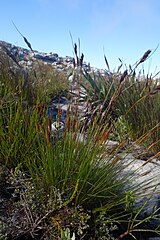
Schoenus arenicola is a species of sedge endemic to the south-west coast of South Africa.

Schoenus megacarpus is a species of sedge endemic to the south-central region of South Africa.

Schoenus prophyllus is a species of flowering plant in the sedge family. It is endemic to the Agulhas Plain region of Western Cape Province of South Africa.

Schoenus ligulatus is a species of sedge endemic to the western regions of the Western Cape Province of South Africa.

Schoenus exilis is a species of sedge endemic to the western areas of the Western Cape Province of South Africa.

Schoenus limosus is a species of sedge endemic to the KwaZulu-Natal and Eastern Cape provinces of South Africa. It is predominantly a species of wet grasslands, which explains its common name.

Schoenus calceolus is a species of sedge endemic to limestone-derived soils in the Agulhas Plain region of South Africa.

Schoenus bracteosus is a species of sedge endemic to the mountains of southern South Africa.

Schoenus compactus is a species of sedge endemic to south-western South Africa.

Schoenus riparius is a species of sedge endemic to the Cape Peninsula of South Africa.

Schoenus galpinii is a species of sedge endemic to eastern southern Africa.

Schoenus cuspidatus is a species of sedge endemic to the Cape region of South Africa where it is found in the provinces of Western Cape and Eastern Cape.

Schoenus complanatus is a species of sedge endemic to the western mountains of the Western Cape Province of South Africa.

Schoenus gracillimus is a species of sedge endemic to the Western Cape Province of South Africa.

Schoenus neovillosus is a species of sedge endemic to the south-western mountains of the Western Cape Province of South Africa.

Schoenus australis is a species of sedge endemic to locations near the southern coast of South Africa.

Schoenus brunnescens is a species of sedge endemic to the Western Cape Province of South Africa.

Schoenus graciliculmis is a species of sedge endemic to regions of the southern Eastern Cape Province and nearby regions of the Western Cape Province of South Africa.

Schoenus inconspicuus is a species of sedge endemic to south-western areas of the Western Cape Province of South Africa.

Schoenus crinitus is a species of sedge endemic to the Worcester region of the Western Cape Province of South Africa.





































